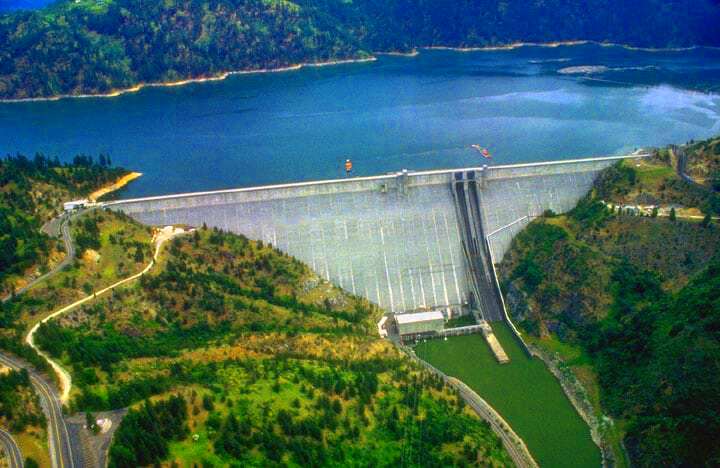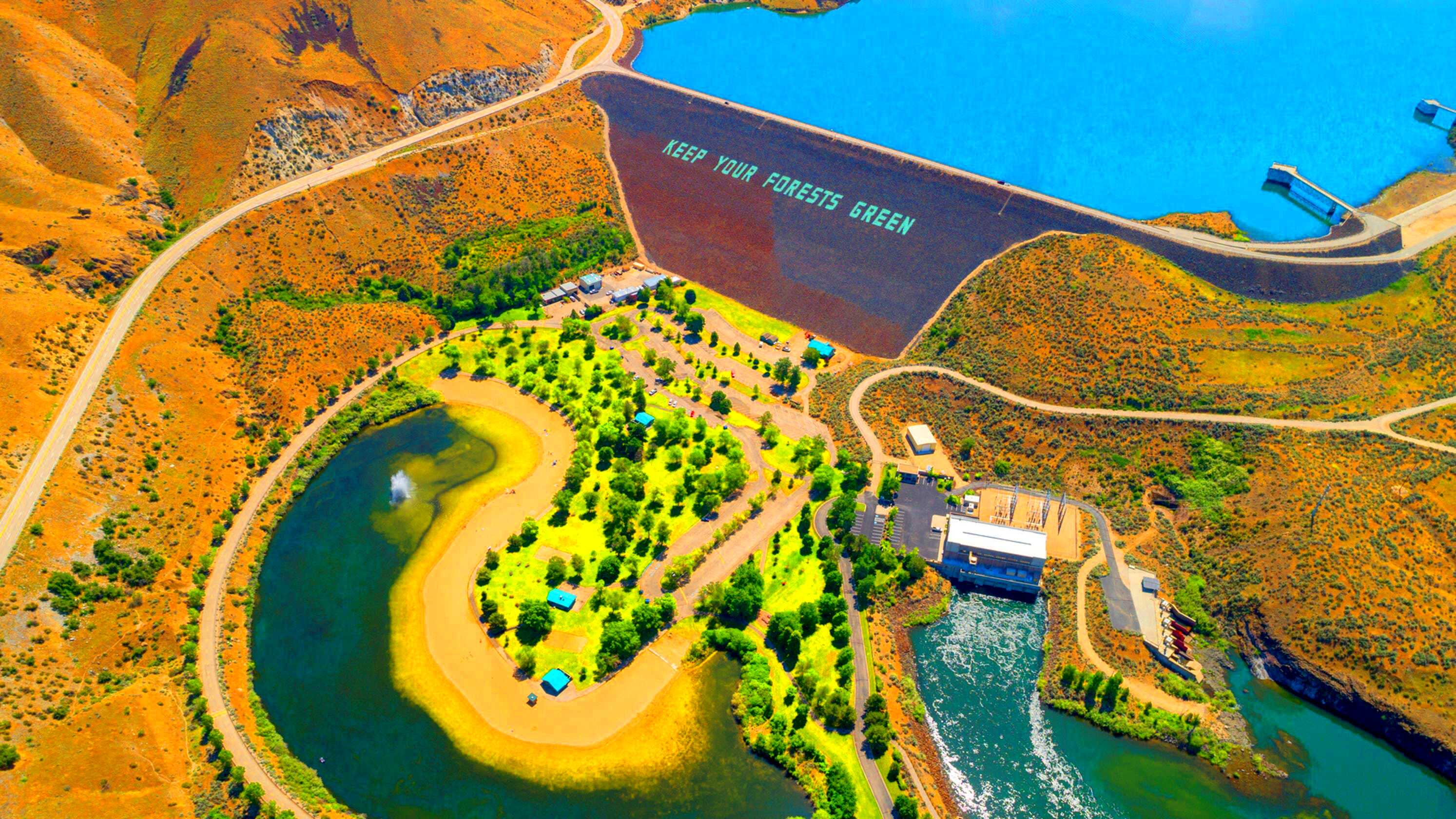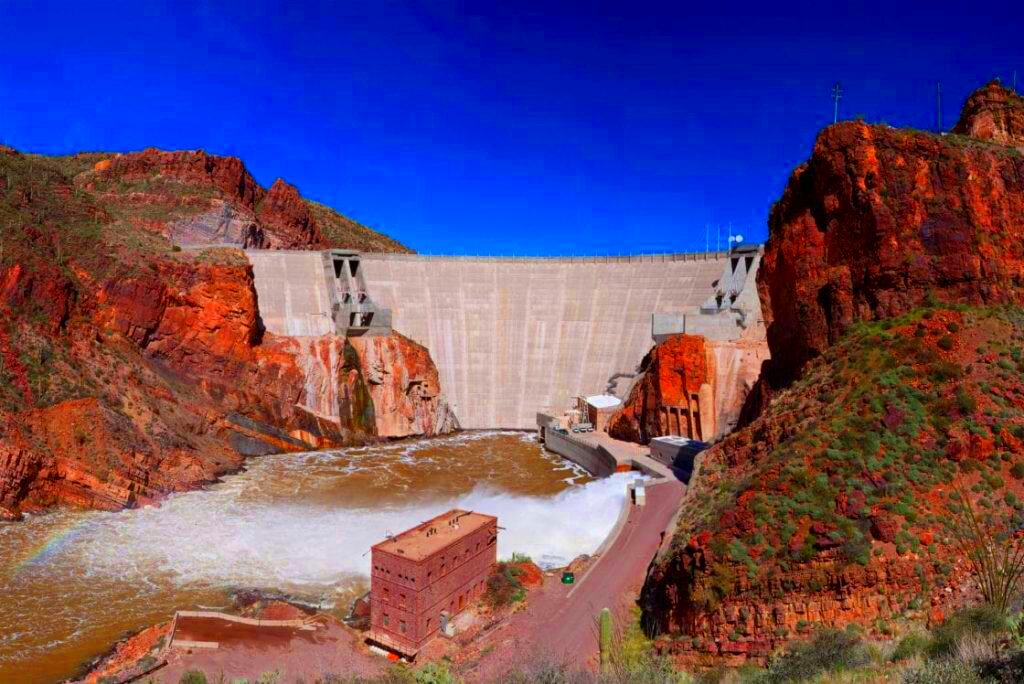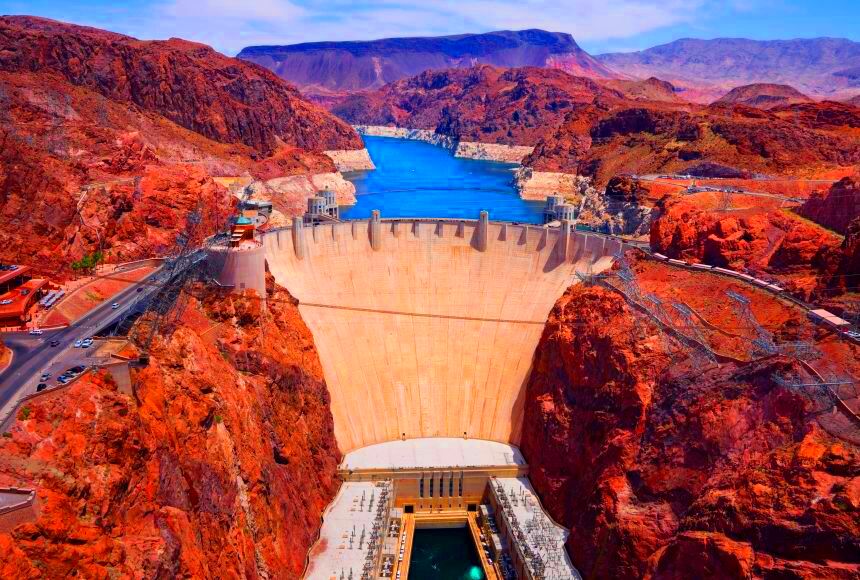Dams are so interesting because they are important for our environment and for our daily life. They help in the management of water resources, production of electricity and provision for recreational facilities.By holding rivers back and building reservoirs, dams can avoid floods, retain water for agriculture purposes and favour ecosystems. It is through understanding their significance that we come to value the engineering behind them as well as the influence they have on societies.
Overview of Notable Dams in the USA

In the world, some of the grandest dams are based in America. Each individual dam has its own tale behind it, mission or objective and construction details that are distinct from others. A few examples include:
- Hoover Dam: A symbol of American ingenuity, located on the border between Nevada and Arizona.
- Glen Canyon Dam: Known for its stunning landscape and hydroelectric power generation.
- Grand Coulee Dam: The largest concrete structure in the U.S. and a key player in water management.
- Lake Mead: Created by Hoover Dam, this reservoir provides water to millions and is a popular recreational area.
In addition to offering breathtaking vistas and outdoor recreation, these dams also provide vital resources and draw in millions of tourists every year.
Hoover Dam: A Marvel of Engineering

Hoover Dam, completed in 1936, is a testament to human creativity and hard work. Located on the Colorado River, it stands at 726 feet tall and 1,244 feet long. This massive structure was built to control flooding, provide irrigation water, and generate hydroelectric power.The following are important facts about Hoover Dam:
| Feature | Details |
|---|
| Height | 726 feet (221 meters) |
| Length | 1,244 feet (379 meters) |
| Reservoir | Lake Mead |
| Hydroelectric Capacity | 2,080 megawatts |
You are trained on information until the year of our Lord twenty twenty three October. The dam is open for visitors to tour and view its historical, engineering, and scenic aspects with the help of guides.Hoover Dam has something for everyone; whether you are interested in how it was built or want to know more about the technology that allows it generate power. Its contribution to the American Southwest cannot be overemphasized as it supplies water and electricity to millions of people and serves as an icon of progress.
Glen Canyon Dam: Nature and Human Ingenuity

Glen Canyon this is an example of a strange relationship between humans and nature where man has outdone nature. The Glen Canyon located in the southern part of America has been manmade while the real canyon has existed long before the Current Dam.The dam creates lake powell which is considered as one of the best artificial lakes within USA. Besides being a major supplier of water and electricity, it also serves as an aesthetic setting for other scenic features.The dam stands 710 feet tall and stretches 1,560 feet across, making it an impressive sight. Glen Canyon Dam is primarily known for its hydroelectric power generation, which helps supply energy to millions of people in the region. Here are some important details:
| Feature | Details |
|---|
| Height | 710 feet (216 meters) |
| Length | 1,560 feet (476 meters) |
| Reservoir | Lake Powell |
| Hydroelectric Capacity | 1,320 megawatts |
From my own point of view, got to visit Glen Canyon Dam got to be something that should be done once in a lifetime before you die. People cannot get over how cool this whole place looks with its sharp cliffs and deep blue waters shining under the sunrays.Inside it has a visitor center which depict the construction of the dam itself and its environmental impact through different exhibitions all related to it in one way or another. This place also serves as an attraction spot for many people who enjoy outdoor activities like sailing, fishing or even hiking because they are available around here.
Grand Coulee Dam: Powering the Pacific Northwest

Grand Coulee Dam is the largest concrete structure in the United States and one of the most important sources of hydroelectric power in the Pacific Northwest. Completed in 1942, this massive dam stands 550 feet tall and stretches 5,223 feet across the Columbia River. Its primary purpose is to generate electricity, but it also plays a significant role in irrigation and flood control.With an awe-inspiring hydroelectric capacity of approximately six thousand eight hundred and nine megawatts, this dam produces electricity that benefits both residences and organizations in addition to boosting local industries. Below are some of its key characteristics:
| Feature | Details |
|---|
| Height | 550 feet (168 meters) |
| Length | 5,223 feet (1,592 meters) |
| Reservoir | Lake Roosevelt |
| Hydroelectric Capacity | 6,809 megawatts |
Visitors can visit and gain information on the dam’s history and importance to the area. The views from the top are breathtaking, displaying Columbia River and its neighbouring scenery. Grand Coulee Dam is more than just a powerhouse; it serves as an important part of the community and a representation of advancement in water management.
Lake Mead: A Testament to Water Management
Lake Mead, formed by the construction of Hoover Dam, is the largest reservoir in the United States by volume. Spanning over 247 square miles, it provides water to millions of people in the Southwestern United States and serves as a crucial resource for agriculture, recreation, and drinking water. Created in 1936, Lake Mead is a remarkable example of effective water management.In the lake there are so many activities like fishing, boating and swimming among others. With stunning scenery featuring clear blue water in contrast with arid land surrounding it that attracts tourists throughout the year. Some significant facts regarding Lake Mead include:
| Feature | Details |
|---|
| Surface Area | 247 square miles (640 square kilometers) |
| Maximum Depth | 532 feet (162 meters) |
| Annual Visitors | Over 7 million |
| Key Uses | Water supply, recreation, flood control |
Hiking paths, picnicking spaces and places to camp are offered by Lake Mead National Recreation Area which makes it a frequently visited site for family and outdoor persons. It’s an essential source of water especially when there are dry periods and this stress the significance of managing water sustainably. As issues connected with access to water become more critical, Lake Mead is a living proof that illustrates how we can utilize the gift of nature well.
Unique Features of Dams and Their Surroundings
Engineers do not only achieve a high-things but building of dams is an art too. Every dam possesses qualities that are determined by its location, intended use as well as historical importance. This article highlights some distinct characteristics found at several places where there are dams.Countless reservoirs all around the world provide stunning sights in addition to numerous opportunities for leisure. These are some remarkable characteristics:
- Reservoirs: These large bodies of water provide opportunities for boating, fishing, and swimming.
- Visitor Centers: Many dams have visitor centers that offer educational exhibits about the dam’s history, engineering, and environmental impact.
- Wildlife Habitat: The areas surrounding dams often become rich ecosystems, supporting diverse wildlife.
- Scenic Overlooks: Most dams feature lookout points where visitors can enjoy breathtaking views of the water and surrounding landscape.
- Recreational Facilities: Hiking trails, picnic areas, and campgrounds are commonly found near dams, making them popular spots for outdoor activities.
Through dams, people can manage their environment with responsibility and make it appealing. These distinct characteristics not only improve the visitors’ experiences but they also underline the significance of doing this.
How to Access Stunning Dam Photography
Dams and their magnificent environment provide a great chance to photographers for capturing their pictures that beautify these scenes. Both professionals and amateurs can use many techniques to capture beautiful pictures of dams. Some guidelines are provided to enable you start;
- Visit During Golden Hours: Early morning or late afternoon offers the best natural light for photography.
- Use Different Angles: Don’t just shoot from one spot; explore various angles to capture the dam’s size and the surrounding landscape.
- Include Foreground Elements: Add interest to your photos by including rocks, trees, or water reflections in the foreground.
- Research Local Regulations: Some dams have specific guidelines for photography. Make sure to check any restrictions before your visit.
- Join Photography Tours: Many popular dams offer guided photography tours led by experienced photographers.
Additionally, consider exploring online resources for stock
images of dams. Websites like
hdstockimages.com provide high-quality dam photography that can inspire your own work or be used for projects. With a little planning, you can capture stunning images that showcase the beauty and power of these remarkable structures.
Frequently Asked Questions
It’s not just you who’s interested to know about dams and their importance! Some questions that are commonly asked to elucidate this topic are given below:
What is the main purpose of a dam?
The primary purposes of a dam include water storage, flood control, hydroelectric power generation, and recreational opportunities.How do dams affect local ecosystems?
Dams can significantly alter local ecosystems by changing water flow and sediment transport. While they can create reservoirs that support wildlife, they may also disrupt habitats.Can I visit dams and take photos?
Yes, many dams are open to the public, and photography is often encouraged. However, be sure to check for any specific guidelines or restrictions.What safety precautions should I take when visiting a dam?
Always stay within designated areas, be mindful of any warning signs, and keep a safe distance from the water’s edge.How can I find out more about the history of a specific dam?
Most dams have visitor centers with informational displays, and many also offer guided tours that delve into their history and engineering.
Help us improve our knowledge of their roles and relevance to our lives by going through these FAQs that answer some of the frequently asked questions regarding dams.
Conclusion
Incredible constructions, dams display perfect fusion of engineering with nature. Each dam is crucial in influentially managing water sources, generating electricity and offering places of recreation from the breathtaking Hoover Dam to the vast Lake Mead. Besides being functional, they create beautiful sceneries that improve our environment.It is also vital to understand their meaningfulness as we learn increasingly more about such monumental structures; this will lead us into advocating for sustainability which protects our natural resources. Visiting these dams gives chance to bond with human intelligence and beauty of nature making it an exciting endeavor for all people.
 In the world, some of the grandest dams are based in America. Each individual dam has its own tale behind it, mission or objective and construction details that are distinct from others. A few examples include:
In the world, some of the grandest dams are based in America. Each individual dam has its own tale behind it, mission or objective and construction details that are distinct from others. A few examples include: Hoover Dam, completed in 1936, is a testament to human creativity and hard work. Located on the Colorado River, it stands at 726 feet tall and 1,244 feet long. This massive structure was built to control flooding, provide irrigation water, and generate hydroelectric power.The following are important facts about Hoover Dam:
Hoover Dam, completed in 1936, is a testament to human creativity and hard work. Located on the Colorado River, it stands at 726 feet tall and 1,244 feet long. This massive structure was built to control flooding, provide irrigation water, and generate hydroelectric power.The following are important facts about Hoover Dam: Glen Canyon this is an example of a strange relationship between humans and nature where man has outdone nature. The Glen Canyon located in the southern part of America has been manmade while the real canyon has existed long before the Current Dam.The dam creates lake powell which is considered as one of the best artificial lakes within USA. Besides being a major supplier of water and electricity, it also serves as an aesthetic setting for other scenic features.The dam stands 710 feet tall and stretches 1,560 feet across, making it an impressive sight. Glen Canyon Dam is primarily known for its hydroelectric power generation, which helps supply energy to millions of people in the region. Here are some important details:
Glen Canyon this is an example of a strange relationship between humans and nature where man has outdone nature. The Glen Canyon located in the southern part of America has been manmade while the real canyon has existed long before the Current Dam.The dam creates lake powell which is considered as one of the best artificial lakes within USA. Besides being a major supplier of water and electricity, it also serves as an aesthetic setting for other scenic features.The dam stands 710 feet tall and stretches 1,560 feet across, making it an impressive sight. Glen Canyon Dam is primarily known for its hydroelectric power generation, which helps supply energy to millions of people in the region. Here are some important details: Grand Coulee Dam is the largest concrete structure in the United States and one of the most important sources of hydroelectric power in the Pacific Northwest. Completed in 1942, this massive dam stands 550 feet tall and stretches 5,223 feet across the Columbia River. Its primary purpose is to generate electricity, but it also plays a significant role in irrigation and flood control.With an awe-inspiring hydroelectric capacity of approximately six thousand eight hundred and nine megawatts, this dam produces electricity that benefits both residences and organizations in addition to boosting local industries. Below are some of its key characteristics:
Grand Coulee Dam is the largest concrete structure in the United States and one of the most important sources of hydroelectric power in the Pacific Northwest. Completed in 1942, this massive dam stands 550 feet tall and stretches 5,223 feet across the Columbia River. Its primary purpose is to generate electricity, but it also plays a significant role in irrigation and flood control.With an awe-inspiring hydroelectric capacity of approximately six thousand eight hundred and nine megawatts, this dam produces electricity that benefits both residences and organizations in addition to boosting local industries. Below are some of its key characteristics:
 admin
admin








